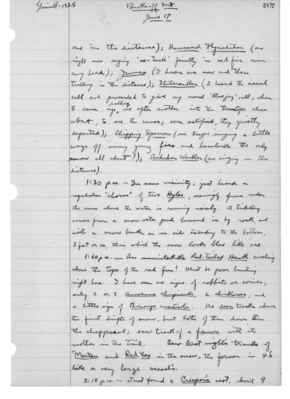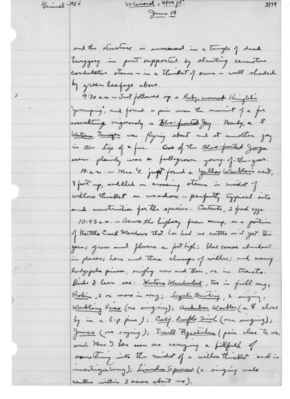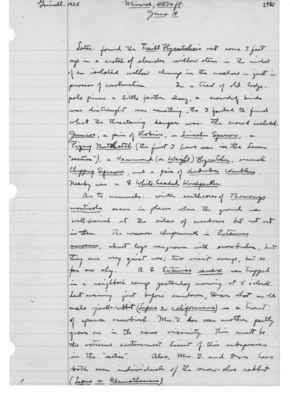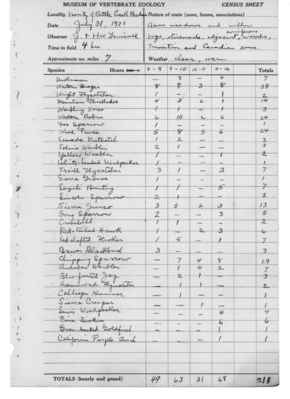Pages That Mention Audubon Warbler
1925: Joseph Grinnell's field notes
S2 Page 11
Collector: Grinnell - 1925 Location: Lassen Section (Mineral) Date: June 15, 1925 Page Number: 2467
Heard a Black-headed Grosbeak in full song in willows, with twinkling aspens and lodgepole pines on either side! 11:30 a.m. - A female Audubon Warbler gave us a long chase. No male at all put in an appearance. The female showed wild solicitude, suddenly appearing as we went under some lodgepole pines at the edge of a meadow. I supposed a nest near, so for fully 20 minutes we kept her in view, she going to the tree tops, at times almost out of sight, then back down near us. Then I began to circle about; and when I got near a certain thicket of very small pines and willows, the bird came within ten feet of me, and went thru with an elaborate display to distract my attention. She spread her tail fanwise, showing the white spots to greatest effect, and quivered her partly spread wings, topping over backwards at the same time, as if unable to hold to her perch. For an instant I thought her foot was caught in the forking twigs! Of course there must have been partly fledged young in the low vegetation somewhere, tho we did not hunt for them. Certainly there was no nest close by. Heard a Meadowlark in full song out on the big meadow at 5:45 a.m. Considerable frost at that hour, even up 3 feet from the ground on the leaves of ceanothus. On way to store saw a pair each of Western Bluebirds and Tree Swallows.
S2 Page 17
Collector: Grinnell - 1925 Location: Lassen Section (Brokeoff Mt.) Date: June 17, 1925 Page Number: 2472
one in the distance); Hammond Flycatcher (one right now saying "see-Tuck" faintly in red fir over my head); Junco (I hear one now and then trilling in the distance); Nutcracker (I heard the nasal call and proceeded to give my usual "bluejay" call, when 5 came up, calling, one after another into the treetops close about, to see the cause; soon satisfied, they quietly departed); Chipping Sparrow (one keeps singing a little way off away young firs and hemlocks the only snow all about!); Audubon Warbler (one singing in the distance). 1:30 p.m. - In same vicinity; just heard a regulation "chorus" of two Hylas, seemingly from under the snow where the water is running noisily. A tributary comes from a snow-water pond hemmed in by rock, and with a snow bank on one side extending to the bottom, 3 feet or so, thru which the snow looks blue like ice. 1:50 p.m. - An unmistakable Red-Tailed Hawk circling above the tops of the red firs! Must be poor hunting right here. I have seen no signs of rabbits or conies; only 2 or 3 Amoenus Chipmunk, 2 chickadees, and a little sign of Thomomys monticola. No deer tracks above the first drifts of snow, but lots of them down thru the chaparral; saw track of a fawn with its mother in the trail. Saw last night's tracks of Marten and Red Fox in the snow, the former in 4's like a very large weasel's. 2:15 p.m. - Just found a Creeper's nest, about 9
S2 Page 24
Collector: Grinnell-1925 Location: Mineral, 4800 ft. Date: June 19 Page Number: 2479
and the structure is ensconced in a tangle of dead twiggery in part supported by slanting ceanothus cordulatus stems - in a thicket of same - well shaded by green leafage above.
9:30 a.m. - Just followed a Ruby-crowned Kinglet's "yerruping," and found a pair upon the summit of a fir assaulting vigorously a Blue-fronted Jay. Nearby, a (female) Western Tanager was flying about and at another jay in the top of a fir. One of the Blue-fronted Jays seen plainly was a full-grown young-of-the-year.
10: a.m. - Mrs. G. just found a Yellow Warbler's nest, 8 feet up, saddled on crossing stems in midst of willow thicket on meadow - perfectly typical site and construction for the species. Contents, 2 fresh eggs.
10:45 a.m. - Across the highway from camp, on a portion of Battle Creek Meadows that has had no cattle on it yet this year; grass and flowers a foot high; blue camas abundant in places; here and there clumps of willow; and many lodgepole pines, singly now and then, or in tracts. Birds I hear are: Western Meadowlark, two in full song; Robin, 2 or more in song; Lazuli Bunting, 2 singing; Warbling Vireo (one singing); Audubon Warbler (a (female) close by in a l-p pine); Calif. Purple Finch (one singing); Junco (one singing); Traill Flycatcher (pair close to me, and Mrs. G has seen one carrying a billfull of something into the midst of a willow thicket and in investigating); Lincoln Sparrow (a singing male centers within 3 acres about us).
S2 Page 25
Author: Grinnell-1925 Location: Mineral, 4800 ft. Date: June 19 Page Number: 2480
Later: found the Traill Flycatcher's nest some 7 feet up in a crotch of slender willow stem in the midst of an isolated willow clump in the meadow - just in process of construction. In a tract of old lodge pole pines a little farther along, a crowd of birds was distraught over something, tho I failed to find what the threatening danger was. The crowd included: Juncos, a pair of Robins, a Lincoln Sparrow, a Pigmy Nuthatch (the first I have seen in the Lassen "section"), a Hammond (or Wright) Flycatcher, several Chipping Sparrows, and a pair of Audubon Warblers. Nearby was a (female) White-headed Woodpecker.
As to mammals: winter earthcores of Thomomys monticola occur in places where the ground is well-drained at the sides of meadows but not out in them. The common chipmunk is Eutamias amoenus, about logs overgrown with snowbushes, but they are very quiet now; two visit camp, but so far are shy. A (female) Eutamias senex was trapped in a neighbor's camp yesterday morning at 5 o'clock. Last evening just before sundown, Dixon shot an old male jack-rabbit (Lepus c. californicus) in a tract of sparse snowbush. Mrs. G. has seen another partly grown one in the same vicinity. This must be the extreme easternmost limit of this subspecies in the "section". Also, Mrs. G. and Dixon have both seen individuals of the snow-shoe rabbit (Lepus w. klamathensis).
S2 Page 86
| MUSEUM OF VERTEBRATE ZOOLOGY | CENSUS SHEET |
| Locality: Vicinity of Battle Creek Meadows | Nature of Route(zone,fauna, associations): |
| Date: July 31, 1925 | Across meadows and willow |
| Observer: J. & H.W. Grinnell | bogs, streamside, adjacent ^coniferous woods; |
| Time in Field: 4 hrs. | Transition and Canadian zones |
| Approximate no. miles: 7 | Weather: clear, warm |
| Species Hours[arrow symbol pointing right] | 8-9 | 9-10 | 10-11 | 11-12 | Totals | |
| Unknown | - | 3 | - | 4 | 7 | |
| Western Tanager | 8 | 9 | 3 | 8 | 28 | |
| Wright Flycatcher | 1 | - | - | 1 | 2 | |
| Mountain Chickadee | 4 | 3 | 6 | 1 | 14 | |
| Warbling Vireo | 1 | 1 | 0 | 1 | 3 | |
| Western Robin | 6 | 10 | 2 | 6 | 24 | |
| Fox Sparrow | 1 | 0 | 0 | 0 | 1 | |
| Wood Pewee | 5 | 8 | 5 | 6 | 24 | |
| Canada Nuthatch | 1 | 2 | 0 | 0 | 3 |
TOTALS (hourly and grand)|49|63|31|68|211




